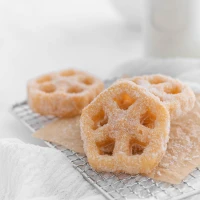Beet puree is more than just a brilliantly hued ingredient—it’s a culinary chameleon capable of elevating dishes with its sweet, earthy essence. Versatile in nature, beet puree infuses meals with a burst of color, a bevy of nutritional benefits, and an element of refined taste that’s hard to match. This vegetable-derived wonder is earning its place in the hearts of gourmet chefs and home cooks alike.
With an ever-growing demand for wholesome, natural foods, incorporating beet puree into recipes is a practice that aligns perfectly with the trend towards clean eating. Whether you’re looking to enhance the visual appeal of a dish or infuse it with the vibrant flavors of garden gems, beet puree is your go-to ingredient. In this comprehensive guide, we will unlock the secrets to creating exquisite beet puree and discover the multitude of ways to use it in your culinary repertoire.
Crafting the Perfect Beet Puree
Discovering the perfect method to create velvety beet puree is the first step to harnessing its full potential.
Selecting Quality Beets: The Starting Point
A paramount factor to achieving the best beet puree is starting with the right base—fresh beets. To select the finest quality:
- Look for beets that feel firm to the touch with smooth skin.
- Choose beets that are uniform in size to ensure even cooking.
- Fresh, green tops indicate that the beets are freshly harvested.
The Cooking Process: Boiling versus Roasting
Different cooking methods can enhance the natural sweetness of beets:
- Boiling is quicker and helps to retain the vivid color of the beets.
- Roasting intensifies the natural sugars, giving the beet puree a deeper flavor.
Pureeing to Perfection
Once your beets are cooked, transforming them into a puree is simple:
- Peel the cooked beets by slipping their skins off under cool running water.
- Chop the beets into uniform pieces for an even blend.
- Use a food processor or blender to achieve a smooth consistency.
- For a thinner puree, consider adding a liquid such as water, broth, or beet cooking liquid.
Beet Puree Culinary Applications
In the realm of culinary applications, beet puree is a versatile component that can be incorporated into an array of dishes.
Main Dishes: A Healthy, Colorful Twist
Sandwich bold flavors and enhance nutritional content:
- Top your savory meatloaf with a glaze of beet puree for a twist on a classic.
- Incorporate beet puree into vegetarian patties for a boost of color and moisture.
Side Dishes: From Plain to Posh
Elevate the ordinary to extraordinary with beet puree:
- Enrich risottos or mashed potatoes with beet puree for additional layers of flavor.
- Swirl beet puree into soups and sauces for a touch of sophistication.
Desserts: Sweet Surprises
Unleash the unanticipated sweetness of beet puree in desserts:
- Chocolate beet cake: The puree adds moisture and subtle earthiness.
- Beet and berry popsicles: A color-sure feast for the eyes, perfect for summer treats.
The Nutritional Palette of Beet Puree
Not only does beet puree shine in terms of taste and presentation, but it’s also a nutritional powerhouse.
Vitamins, Minerals, and Antioxidants – A Health Trifecta
Loaded with nutrients, beets offer:
- Vitamin C: Essential for immune function.
- Potassium: Conducts nerve signals and muscle contractions.
- Betalains: These pigments possess antioxidants that combat inflammation.
Dietary Fiber: For Digestive Wellness
Beet puree is rich in fiber, aiding in:
- Regular bowel movements.
- Lowering cholesterol levels.
- Modulating blood sugar spikes.
Storing and Preserving Beet Puree
To maintain the freshness and vibrancy of beet puree, proper storage is crucial.
Short-Term Storage Solutions
Keep beet puree vibrant:
- Store in an airtight container in the refrigerator.
- Express a layer of lemon juice on top to prevent oxidation.
Long-Term Preservation Techniques
For longevity, explore these options:
- Freeze in ice cube trays for convenient portion sizes.
- Can the puree for shelf-stable storage, using safe canning practices.
The Beet Puree Advantage in Specialty Diets
Beet puree isn’t just for epicureans—it’s a boon for various dietary needs.
Vegan and Vegetarian Recipes: Plant-Based Wonder
Beet puree serves as an ideal base or ingredient in vegan and vegetarian dishes:
- Substitute beet puree in baking recipes that call for eggs.
- Use beet puree as a natural food dye for vibrant plant-based dishes.
Gluten-Free and Low-Carb Alternatives
- Swap high-carb sides with beet-infused alternatives for a health-conscious choice.
- Thickening soups or sauces with beet puree is an excellent gluten-free option.
Pairing Beet Puree with Complementary Flavors
Mastering the art of flavor pairing is essential when working with such a distinct ingredient.
Spices and Herbs That Accentuate Beets
Highlight beets’ natural sweetness with condiments:
- Fresh dill or mint for a refreshing contrast.
- Cumin or coriander for a warm, earthy undertone.
Acids and Fats: Balancing the Beet
Strike a balance in your dish’s profile:
- Goat cheese or feta provide a creamy, tangy counterpart to earthy beets.
- A squeeze of citrus or a dash of vinegar can cut through the sweetness.
Conclusion: The Versatility of Beet Puree
Beet puree is a multi-dimensional ingredient that’s capable of infusing dishes with both tantalizing tastes and beneficial nutrients. Its versatility lends itself to an array of recipes from starters to mains and desserts, while its nutritional attributes align with current healthy eating trends. It provides a profound service to those adhering to specialty diets, offering new avenues for culinary creativity.
To tap into the gifted essence of beets is to unlock the full spectrum of potential held within these crimson treasures. Through the artful application of beet puree, we revere not just the versatility and vibrancy of this underrated vegetable, but also celebrate its emergence as a staple in contemporary cooking narratives. Embrace the puree from these garden gems, and watch as each dish you create becomes a masterpiece of flavor and health.










